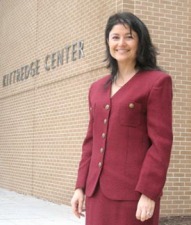The Changing Workforce

Iraida Delgado from the Kittredge Center
By Iraida Delgado,
Business Account Representative, The Kittredge Center for Business & Workforce Development, Holyoke Community College.
Today's workforce is changing. In the years to come, an increasing number of baby boomers will retire and/or
relocate and take from the work force decades of experience and expertise.
At the same time, population forecasts suggest that changing demographics will create a dip in the talent pool.
Companies are discovering they need new initiatives to attract and keep good employees. A recent study suggests regional companies should take note of what is being done to address these changes.
Workforce and education
The projected changes in the region's demographics have been documented in the "New England 2020: a Forecast of Educational Attainment and its Implications for the Workforce of New England States" commissioned by the Nellie Mae Education Foundation and released in June 2006.
According to the study, two of the areas affected by the demographic changes, which also reflect the national trend, are projections for the region's workforce and educational trends.
The research makes the following projections:
The working age populations (25 64 year-olds) in Massachusetts, Connecticut and Rhode Island are declining.
By 2020 nearly half of the 25-29 year-olds will be minorities in the three southern New England states (Massachusetts, Connecticut and Rhode Island).
Predicted minority growth will help fill jobs and fuel the economy in these states.
New England states (with the exception of New Hampshire) will find that a decreasing percentage of their young population will hold a bachelor's or higher-level degree.
The encouraging news is that initiatives are underway both nationally and regionally to address both the issue of capturing the expertise and experience of retiring workers and preparing to integrate minority entrants into the workforce.
Replenishing the talent pool
On a national level, a few companies including General Electric, Dow Chemical and Northrop Grumman have programs in place to capture their older workers' knowledge and pass it on to younger workers. An article in Fortune magazine ("How to Battle the Coming Brain Drain," March 21, 2005), described how these companies have implemented programs to capture the explicit and tacit knowledge of senior workers. Explicit knowledge is the technical know-how that can be quantified; tacit knowledge includes the stories, networks and insights people develop during a career that are more difficult to document.
Regionally, an international company with a plant in Windsor, Conn. has contracted with staff from the Kittredge Center for Business and Workforce Development to provide knowledge management services as part of a succession planning strategy. Some of their senior employees (the knowledge base) are approaching retirement age and will be leaving the company or transferred to other company locations. The company is facing business changes that require hiring a significant number of new employees.
In the past twenty-five years staffing levels had been fairly static, and new hires had been trained on a one-to-one basis. This approach is no longer feasible and tacit knowledge had not been formally documented to provide the training curriculum needed for the new-hires.
We have helped with this transfer of knowledge by:
Providing a needs analysis to identify the required knowledge and skills for new hires.
Determining the best practical methods for capturing that knowledge in a curriculum and designing a sequential training program with specific courses, learning objectives, and instructional strategies.
Developing an implementation plan.
Determining the best methods for reliable feedback on training effectiveness within the organization.
Filling the training gap
By the same token, as the Nellie Mae-funded study shows, down the road new employees may not only have to be brought up to speed on the formalities of a specific position but also with industry-specific remediation.
Locally, a company in Holyoke has established a pilot program for its employees to provide language and math instruction. The plant manager refers to the pilot program as a strategy for employee commitment and retention.
He has also expressed interest in providing cross-cultural training for managers and frontline staff and conversational Spanish for interested employees.
The current program includes:
The development of a learning lab with computers that provide interactive multimedia software in English as Another Language and Mathematics.
Two half-days-a-week of supplemental life instruction for employees in both subjects.
Diagnostic evaluations to identify each participant's progress and level of proficiency.
The manager's and the company's actions result from their understanding the needs of their workforce and making strategic decisions that will enable the organization to use its knowledge resource as a competitive advantage in the future.
The company has invested out of pocket for the one year pilot project. A sister company has asked us to submit a proposal for ESL courses, and they are going to apply for Workforce Training Fund dollars.
The 2020 workforce
The region can expect change in its workforce, whether through attrition, retirement or migration. And change can be good when the region and the businesses prepare for it. Small-to-medium companies can attract, retain, and nurture employees, young and multi-cultural, to meet present and future workforce demands. In addition to the case studies mentioned above, other initiatives to consider include:
Provide forums to encourage employee participation in decision making.
Promote inclusiveness with cross cultural communication training for managers and front line staff.
Track diverse representation throughout the organization.
Facilitate employee development using interactive employee/manager performance assessments.
Use opinion surveys to gain employee feedback on company practices.
Be ready for a successful future
The dynamics of a changing work force have implications for businesses. They can ignore the reality of these changes, resist the reality, or use the information to influence strategic decisions for their organization, grow their company and increase their competitive edge.
Iraida Delgado (idelgado@hcc.mass.edu) is a Business Account Representative with The Kittredge Center for Business & Workforce Development at Holyoke Community College.
